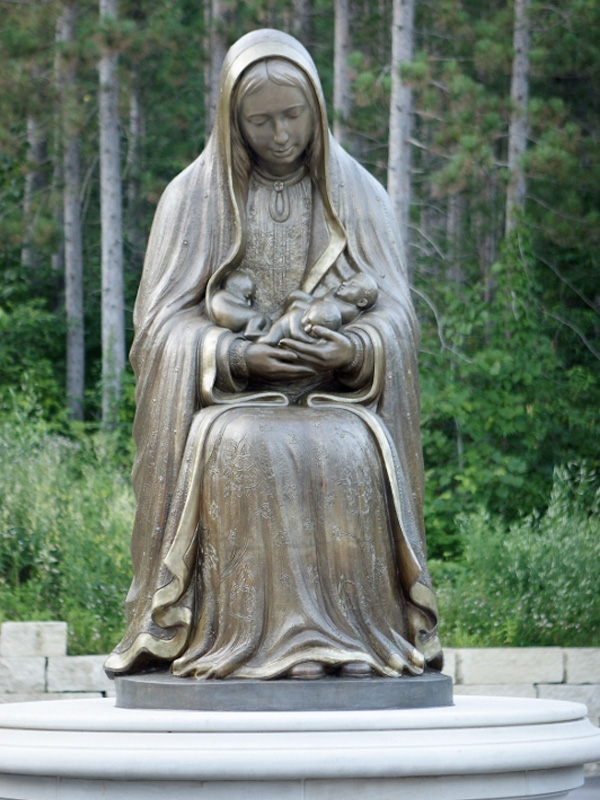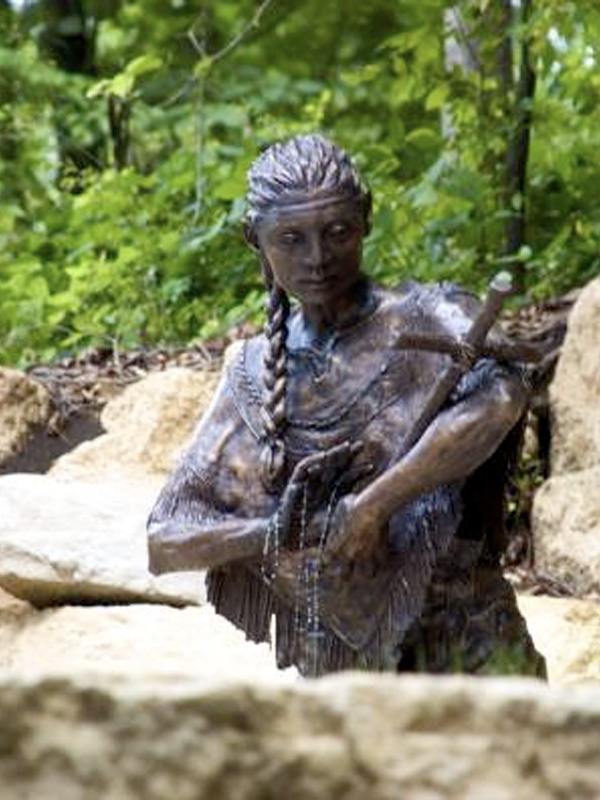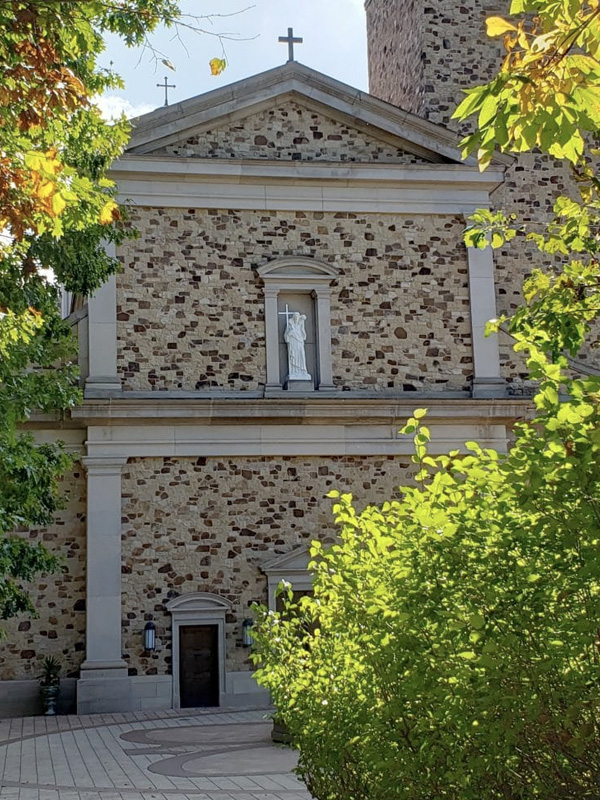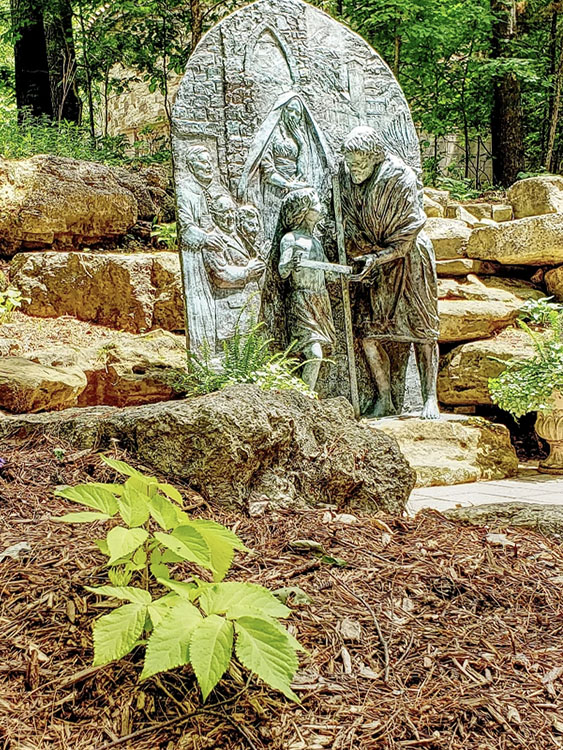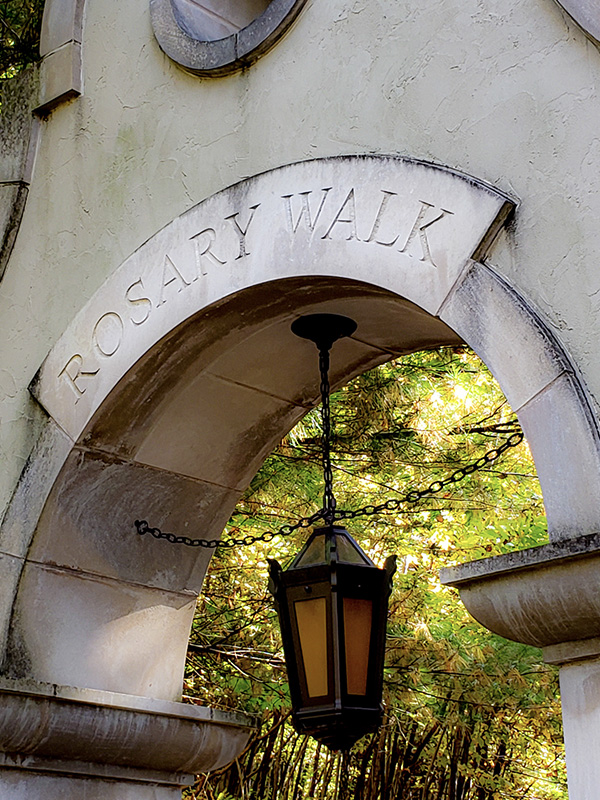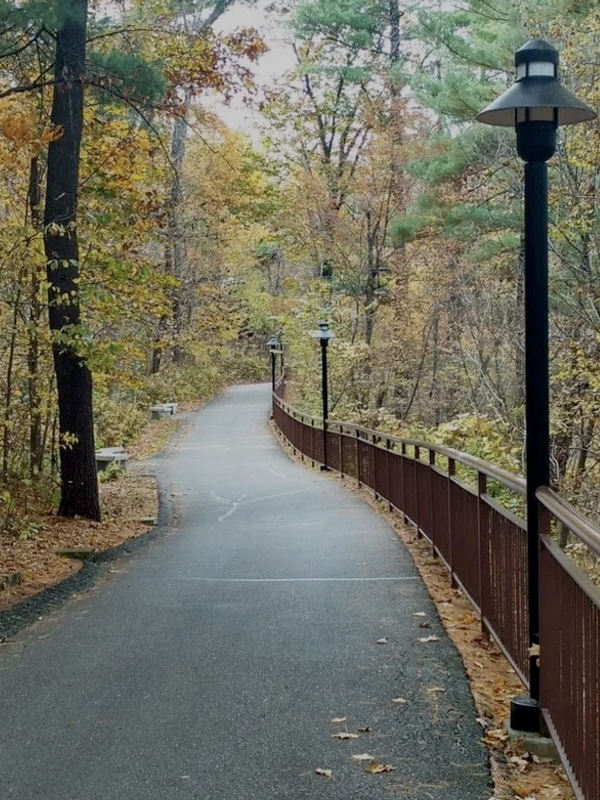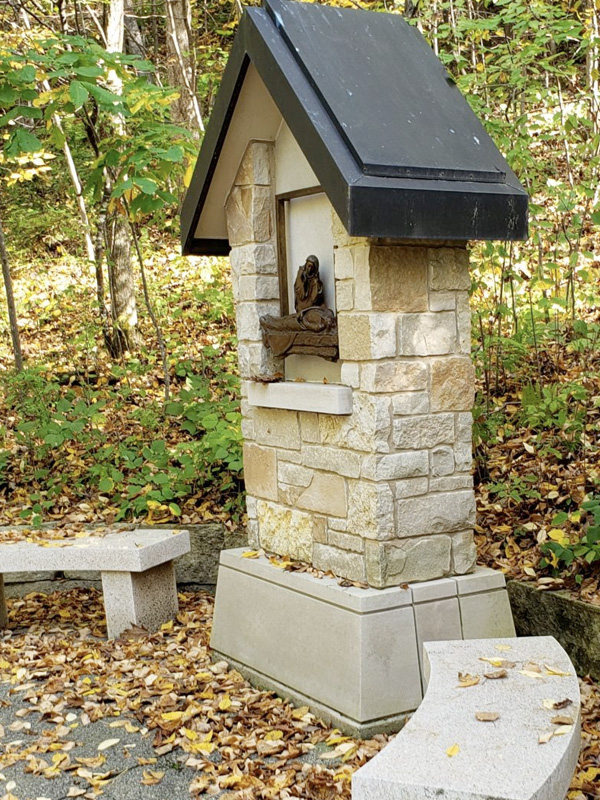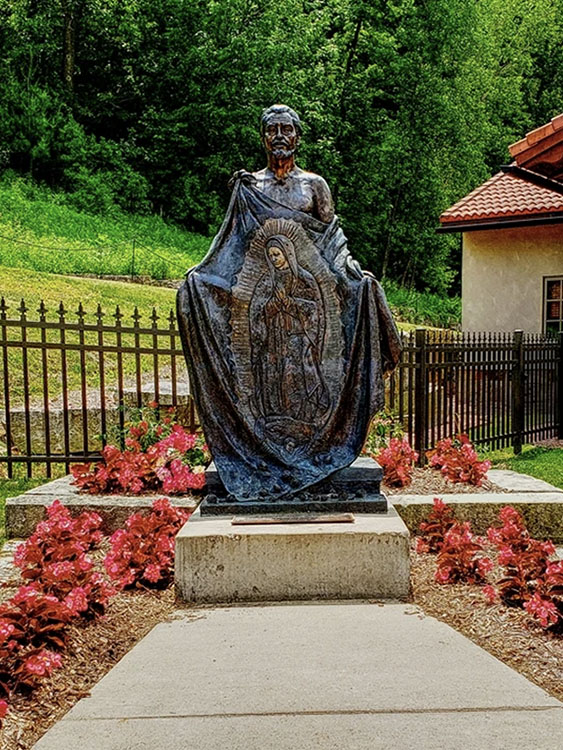Devotional Areas
 The Shrine is a spiritual destination with many beautiful chapels, statues, gardens, and devotional areas for visitors and pilgrims from all over the world.
The Shrine is a spiritual destination with many beautiful chapels, statues, gardens, and devotional areas for visitors and pilgrims from all over the world.
Take a Look Around
Saint Kateri Tekakwitha
Saint Kateri Tekakwitha is a special patron of the Shrine of Our Lady of Guadalupe in La Crosse, Wisconsin. Her intercession is uniquely fitting for a shrine dedicated to the Mother of the Americas–as a Native American, Saint Kateri is one of the first flowers of heroic sanctity in North America; more, her sanctity was nurtured and strengthened by a strong devotion to Mary, especially through the Holy Rosary.
In addition, she is also the patron of those who have lost parents. Her care for those who suffer makes her a fitting patron for the Shrine’s Memorial to the Unborn.

The Shrine honors the memory of Saint Kateri Tekakwitha with an outdoor devotional area. Pilgrims can find it nestled among the trees along the Meditation Trail leading to the Shrine Church. The devotional area was dedicated on July 30, 2008. It features a bronze statue sculpted by Cynthia Hitschler of Celebration Studios in Wildwood, Missouri. Commissioned with the help of the Native American community, the sculpture depicts the essence of the spiritual life of Saint Kateri: having gone to the woods to be alone with Our Lord, as she frequently did, she cradles in her left arm a cross fashioned together out of fallen branches she found there, while wrapped around her right hand and arm is a Rosary, one of her main attributes.
Kateri Tekakwitha is the patron saint not only of Native Americans and those who have lost parents but also of ecologists, ecology, environmentalists, the environment, people in exile, and people ridiculed for their piety. Known as the Lily of the Mohawks, she overcame great suffering and persecution in her journey to the faith and once baptized lived her life radically for Christ until her death at a young age. Her last words were “Iesos konoronkwa,” “Jesus, I love You.” She was canonized October 21, 2012, by Pope Benedict XVI.
The Saint Kateri Tekakwitha devotional area offers pilgrims to the Shrine of Our Lady of Guadalupe the opportunity to reflect on the example of this brave and gentle saint of the Americas. Pilgrims can ask for her intercession for their own needs and intentions. Saint Kateri especially offers her prayers for a great love for the Blessed Mother and her Son Jesus.
Votive Candle Chapel
The Mother of Good Counsel Votive Candle Chapel is the first stop along the Meditation Trail at the Shrine of Our Lady of Guadalupe. It includes over 700 votive candles which can be lit as a way to offer up prayers to God through the Blessed Mother’s intercession.
The chapel was dedicated by Raymond Leo Cardinal Burke on the Feast of Our Lady of Guadalupe, December 12, 2002. In his homily on the occasion of the blessing, then-Bishop Burke said, “The Virgin Mary, under her title of Mother of Good Counsel, bids us to come to her Son and to learn from Him what we should do” (cf. John 2:5).
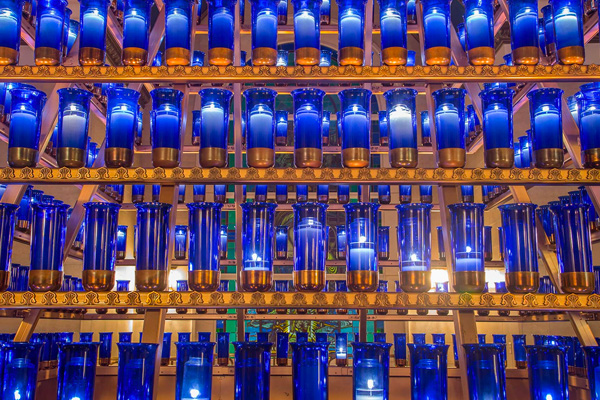
The Votive Candle Chapel expresses the unfailing intercession of our Blessed Mother on our behalf. Under her particular care of her role as Mother of Good Counsel, it reminds pilgrims that Mary leads them to Christ, the Wisdom of God Incarnate. It is a fitting place for pilgrims to begin their journey from the Pilgrim Center to the Shrine Church: leaving the Pilgrim Center marks a spiritual journey away from everyday life toward an encounter with the Lord, and the chapel offers pilgrims an opportunity to draw close to Our Lady as they embark on their ascent to her Shrine, which ultimately leads to her Son.
From a distance, the intense glow of candles beckons a warm welcome. The candle rack inside the chapel measures 16 feet high and 12.5 feet wide and contains over 700 candles that pilgrims can request to be lit for periods of weeks, months, or years. The candles are constantly burning to represent the ceaseless prayer of God’s children and of their heavenly Mother for the salvation of our world.
The interior of the chapel is porcelain tile manufactured in Italy, while its exterior is a blend of both field and cut limestone. The spire was custom designed for the Shrine. Stained glass windows honoring Mary under her titles of Our Lady of Fatima, Our Lady of Knock, Mother of Good Counsel, Our Lady of Sorrows, Our Lady of Loreto, Our Lady of Lourdes, and Our Lady of the Miraculous Medal were created by Willet Hauser of Winona, Minnesota.
Lighting of votive candles is a tradition that goes back to the Old Testament, when a perpetual light was kept burning in temples before the presence of God (Lev 24: 2-4). In the New Testament, it is Christ Who is the Light of the World (John 8:12), and the sanctuary lamp in the church alerts us to the Real Presence of Christ in the tabernacle. At shrines, vigil lamps are lit by the faithful as an act of devotion. The word “votive” goes back to the ancient custom of lighting candles in fulfillment of some private vow (votum). The burning flames are a visible reminder of a prayer intention, allowing the candle to “keep vigil” when the individual cannot be present.
Click Here to light a candle.
Saint Joseph the Workman
Father Anthony Brankin, of the Archdiocese of Chicago, was commissioned by the Shrine of Our Lady of Guadalupe to create a unique bronze sculpture for
the outdoor Saint Joseph the Workman devotional area. This work, one of Father Brankin’s largest, took more than a year to conceptualize and create. The final finishing and addition of the fine patina was completed only days before the sculpture was delivered to the Shrine.
Originally conceived to be a bronze statue of Saint Joseph the Workman, the
commission decided it would be important to emphasize Saint Joseph’s foster fatherhood of Christ. The portrayal of Joseph was to include all of his qualities that enabled him to love, protect, and teach the boy Jesus as He grew in wisdom, age, and grace in Nazareth, as well as to portray those same qualities in Saint Joseph that modern fathers must aspire to, showing that Saint Joseph is both their patron and their model.
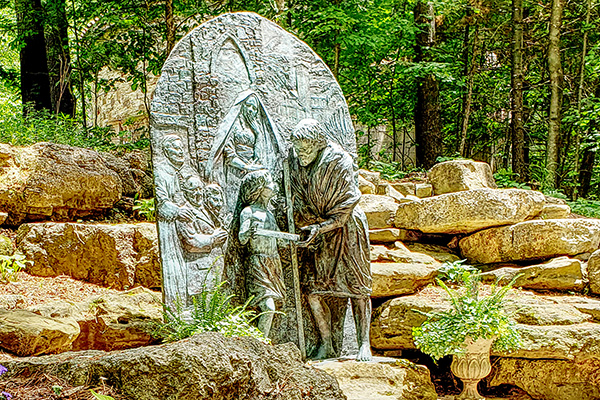
The bronze sculpture depicts a humble scene in Nazareth where the carpenter Joseph is shown teaching the boy Jesus how to work with wood. Jesus and Joseph glance at each other with peaceful looks—reflecting their quiet love and admiration for each other.
In order to establish some ironic drama, Jesus and Joseph have lashed together two planks of wood; they fashion a cross. Indeed, a premonition of the future seizes Mary; thus, she is seen gasping, putting her hand to her mouth. The bronze also shows Cardinal Burke [then Archbishop Burke] and Robert and Lucille Swing, who gave the original 70 acres of land to the Shrine. They are in prayer before Mary at the entrance to the home, turning their heads toward Jesus and Joseph in this quiet revelation of His most Merciful Death. Once again it is shown that devotion to Mary, as always, leads to her Son.
Unlike many artists, Father Brankin sculpts the heads first, in order to be constantly aware of the presence of the subject and to be inspired early on. Father Brankin likes to think that the figure he is sculpting is right there with him to guide his hand and to encourage his labors. When the sculptor steps back, “The eyes of the figures seem to cast just the right glance and the fingers curl just so!”
Then he adds, “Oh, that sends a cheer to my heart and a tear to my eye. And I know that I am as near to Heaven as I can be on earth.”
Father Brankin says God has given art to humanity so that we might be able to participate with and anticipate the inexpressible joys of Heaven.
Without words, and more surely than with them, art communicates God—His Knowability, His Essence, His Attributes.
The Saint Joseph the Workman devotional area was dedicated on September 21, 2007.
Rosary Walk
The Rosary Walk at the Shrine of Our Lady of Guadalupe sits at the farthest point of the pilgrim’s journey, just past the Shrine Church and adjacent to the Stations of the Cross. Dedicated on December 8, 2007, by then-bishop Raymond Leo Burke, the Rosary Walk features four hand-built alcoves of indigenous stone, one for each set of mysteries. Each mystery is depicted in a beautiful ceramic-style image inlaid within the alcoves. On the flanks above each alcove are descriptions of the mysteries taken from Pope Saint John Paul II’s Apostolic Letter on the Rosary, Rosarium Virginis Mariae, as well as the Hail Mary written in English, Spanish, Hmong, and Nahuatl (Aztec).
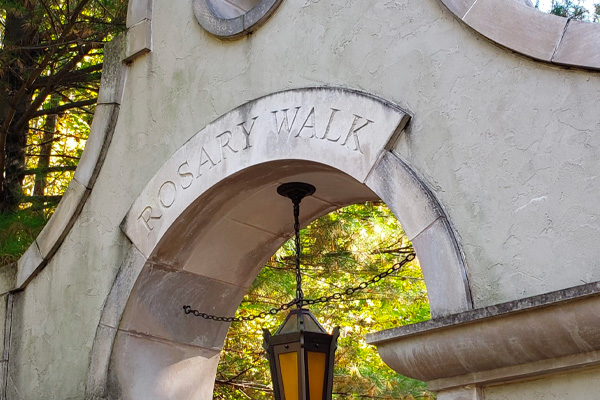
The archway and alcoves of the Rosary Walk were designed by Michael Swinghammer, of River Architects in La Crosse, who also played a principal role in the construction of the Shrine Church.
Artist Anthony Visco, of Atelier of the Sacred Arts in Philadelphia, Pennsylvania, created the twenty images of the mysteries, along with symbols in the corners of the tiles. The images are done in the “azulejos”, or blue and white ceramic style of Lisbon, Portugal, to reflect the Marian message.
Visco said of the images: “I wanted an immediacy to them, so that they can be recognized by people from far away. Each mystery had to have its own distinct character, its own distinct composition, and its own distinct light source, something that was almost supernatural. I wanted to show the variety of light in our lives as it comes through Christ.”
The Rosary Walk is a fitting way for pilgrims to draw closer to Christ and His mother through contemplation and prayer. As a prayer given to us by the Blessed Mother and one which at Fatima she asked the faithful to pray daily, the Rosary is an excellent way for pilgrims to seek Our Lady’s intercession while meditating on the Joyful, Luminous, Sorrowful, and Glorious Mysteries of Christ’s Incarnation and Redemption. As we pray the Rosary, we journey, in a certain sense, through the life of Our Lord with Our Lady. In this way, praying the Rosary is connected to pilgrimage–a devotional journey with the goal of drawing closer to Christ.
Pope Saint John Paul II, whose papal ministry was so strongly marked by devotion to the Blessed Virgin Mary, said in one of his Regina Caeli addresses, “Let us pray the Rosary, if possible every day, either by ourself or in community. The Rosary is a simple prayer, but profound and very effective, even to ask favors for families, communities, and the world.”
Cardinal Burke, founder of the Shrine, echoes the pope in greatly encouraging this prayer. “By praying the Rosary daily, we draw near to the Mother of Our Savior, who teaches us, as she taught the wine stewards at the Wedding Feast of Cana: ‘Do whatever He [Jesus] tells you’ (John 2:5). She, whom Our Savior gave to us as our Mother–the Mother of Divine Grace–helps us to stand faithfully, with her, beneath the Cross of Our Lord, one in heart with her Immaculate Heart in the glorious pierced Heart of Jesus (cf. John 19:25-27). With her, we share in the Triumph of the Cross.”
Pilgrim Path
Like Juan Diego ascending Tepeyac Hill to meet the apparition of Our Lady of Guadalupe, pilgrims go up the Pilgrim Path from the Pilgrim Center to the Shrine Church, drawn by Our Lady to seek a deeper life in Christ. Along the way, pilgrims have the occasion to spend time in prayer at the Mother of Good Counsel Votive Candle Chapel, the Saint Kateri Tekakwitha Devotional Area, the Saint Joseph the Workman Devotional Area, the Saint Juan Diego Statue in the plaza of the Shrine Church, the outdoor Stations of the Cross, and the Rosary Walk.
“Since the Solemn Dedication of the Shrine Church of Our Lady of Guadalupe, Christ, God the Son Incarnate, has been dwelling here and has been active here for the salvation of souls. Were Christ not here, in an extraordinary way, it would make no sense to come here on pilgrimage. Some people cannot understand why it is so difficult to get to the church. I would not say it is so difficult, but it is a walk and it takes some time and it takes some energy. That journey itself is meant to underline the fact that this is a pilgrimage. We do not just drive up with the car, but we make an effort to arrive at the church. If someone has trouble walking we have, of course, the famous carts that bring them up. Nevertheless, you make a journey up to the church. The pilgrim leaves his familiar surroundings to climb the pilgrim path leading to the Shrine Church because he wants to meet Our Lord. He indeed sees Our Lord, he encounters Our Lord, praying in the Shrine Church before the Blessed Sacrament, in the Sacrament of Penance and, most wonderfully of all, in the Sacrament of Holy Eucharist.” —Cardinal Burke
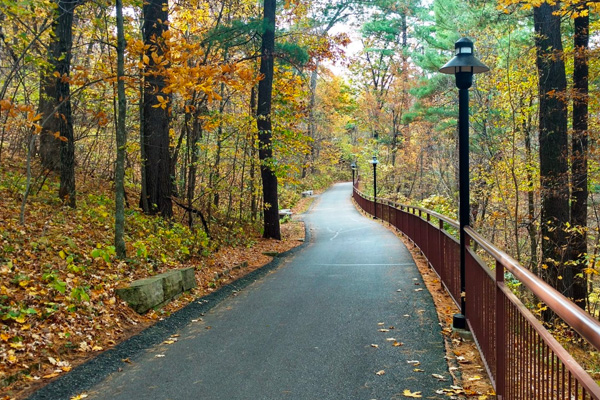
Stations of the Cross
The Stations of the Cross at the Shrine of Our Lady of Guadalupe are located just past the Shrine Church and adjacent to the Rosary Walk. Winding through the wooded landscape of the Wisconsin hills, the fourteen bronze Stations are mounted in alcoves of indigenous stone and are each flanked by stone benches to allow pilgrims a place of rest and contemplation. The Stations were designed by Anthony Visco of Atelier of the Sacred Arts in Philadelphia, Pennsylvania. They were dedicated on the feast of Saint Juan Diego, December 9, 2004, by Raymond Leo Cardinal Burke.
Pilgrims enter the Stations through the Way of the Cross Archway, which was blessed by Cardinal Burke on December 12, 2015.
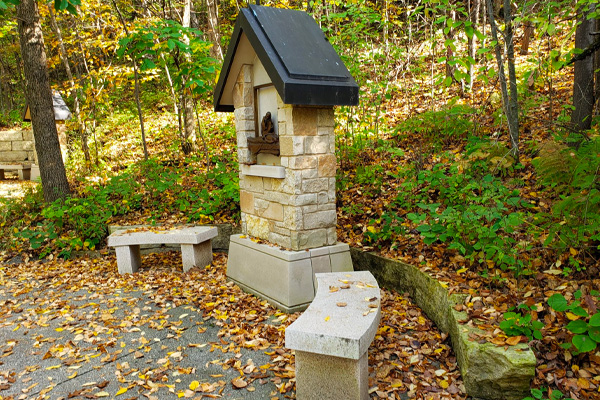
On each side of the archway are bronze panels depicting Bernini’s Angels of the Passion of the Ponte Sant’Angelo at the Vatican. The four angels hold eleven instruments and symbols of the Passion. The number eleven signifies the number of Christ’s Apostles, excluding Judas. Facing the Archway, the panel on the left side shows the angel holding the column of Christ’s scourging and the whip. The right panel shows the angel holding the Cross with INRI inscription and the nails. On the other side of the Archway, the panel on the left side shows the angel holding the spear, sponge, and crown of thorns. On the right panel, the angel holds Veronica’s cloth, and at her feet are Christ’s robe and the dice that shows the total number eleven, again symbolizing the eleven Apostles.
The Stations are an integral part of the Shrine as a place of pilgrimage. During his homily at the Archway’s blessing, Cardinal Burke said:
“Walking through the Archway, we begin our contemplative prayer at each of the fourteen Stations, and we come to understand more fully the profound meaning of our life pilgrimage, along which Christ accompanies us, urging us to take up our Cross with Him, in order that we may find joy and peace in this life, and reach our final destiny, our true and lasting home with God the Father.”
“The Stations of the Cross are a most treasured devotion in the Church,” explains Cardinal Burke. “This devotion assists us in a direct and practical way to meditate upon all that it meant for Our Lord to suffer and die for us, to save us from our sins and to win for us the gift of everlasting life. When we cannot travel to the actual places in the Holy Land where Our Lord accomplished our salvation, we are able to make the Way of the Cross, mystically uniting ourselves to the Lord in the very places made holy by Him Who is All Holy. Walking and praying the Way of the Cross brings us to an encounter with God’s love for us, His providence in our lives, His example of Mercy poured forth from His pierced side, the Fountain of Mercy at the moment of His death!”
After completing the Stations, pilgrims can continue to the Rosary Walk or return to the Shrine Church.
Saint Juan Diego Statue
The Statue of Saint Juan Diego that greets pilgrims as they begin their pilgrimage at the Shrine is a gift from His Eminence, Norberto Cardinal Rivera Carrera, Primate of Mexico, on the occasion of the dedication of the Church of the Shrine, July 31, 2008.


